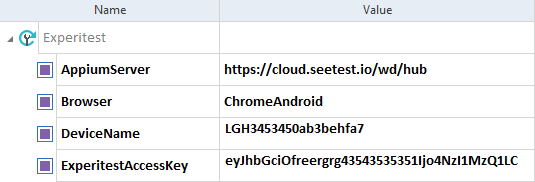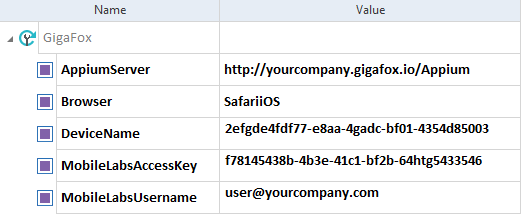Configure tests in online clouds
You can run Mobile Engine 3.0 tests on cloud devices, emulators, and simulators. To do so, you must create specific test configuration parameters (TCPs) for each online cloud. You can use the following online clouds:
You can also run your mobile tests on BrowserStack. However, Tricentis doesn't guarantee full functionality or usability of this feature. For detailed information, see this Tricentis Knowledge Base article.
Cloud TCPs overview
The table below lists all available TCPs for online clouds.
|
Mobile TCP |
Experitest |
GigaFox |
Perfecto |
Sauce Labs |
|---|---|---|---|---|
|
■ |
■ |
■ |
■ |
|
|
Browser (hybrid and web app) |
■ |
■ |
■ |
■ |
|
■ |
■ |
■* |
■ |
|
|
■ |
■ |
■ |
■ |
|
|
■ |
■ |
■ |
■ |
|
|
■ |
■ |
■ |
■ |
|
|
■ |
■ |
■ |
■ |
|
|
■ |
■ |
■ |
■ |
|
|
■ |
■ |
■ |
■ |
|
|
■ |
■ |
■ |
■ |
|
|
■ |
■ |
■ |
■ |
|
|
■ |
■ |
■ |
■ |
|
|
* You don't need to specify the DeviceName TCP for Perfecto if you use OSVersion, DeviceManufacturer, DeviceModel and IsSimulator instead (see chapter "Dynamic device allocation in Perfecto"). |
||||
For a list of all mobile TCPs, see chapter "Mobile TCPs overview".
Enable controls visibility check in the clouds

|
By default, Mobile Engine 3.0 checks controls visibility for local test automation and it skips the visibility check for test automation in the supported clouds. You can enable or disable the visibility check depending on your mobile application and performance requirements. Tricentis recommends disabling the visibility check if you run your tests in the clouds that are not supported. To enable or disable the visibility check only for test execution, create the TCP SkipVisibilityCheck and set its value to True or False depending on whether you want to skip the visibility check or not. To enable or disable the visibility check for both the Mobile Scan and test execution, follow the steps below:
|
Specify TCPs for Experitest
To run your tests in Experitest, specify the following TCPs:
|
Mobile TCPs |
Description |
|---|---|
|
AppiumServer |
Enter https://cloud.seetest.io/wd/hub. |
|
DeviceName |
Enter the serial number of your Experitest device. Alternatively, you can set Desired Capabilities and use the capability Device Query introduced by Experitest. For more information on Device Query, see the Experitest documentation. |
|
ExperitestAccessKey |
Enter the access key of your Experitest account. To get the access key, follow the steps below:
|
|
ExperitestAppiumVersion |
Optionally, use this parameter if you want to use different Appium version than 1.20.2. The default Appium server version for Experitest test execution is 1.20.2. |

|
In this example, you configure a test for a mobile web application in Experitest.
TCPs for a mobile web application on an iOS device in Experitest |
Specify TCPs for GigaFox (ex. Mobile Labs)
To run your tests in GigaFox, specify the following TCPs:
|
Mobile TCPs |
Description |
|---|---|
|
AppiumServer |
Enter the address of the GigaFox Appium server. By default, this is http://yourcompany.gigafox.io/Appium. Test automation requires Appium version 1.20.2. |
|
DeviceName |
Enter the GigaFox ID of your device. To find the GigaFox ID of your device, follow the steps below:
|
|
MobileLabsAccessKey |
Enter the API Token of your GigaFox account. To find your API token, follow the steps below:
|
|
MobileLabsUsername |
Enter the user name of your GigaFox account. |

|
In this example, you configure a test for a web application on an iOS device in GigaFox.
TCPs for a mobile web application on an iOS device in GigaFox |
Specify TCPs for Sauce Labs
To run the tests in Sauce Labs, specify the following TCPs:
|
Mobile TCPs |
Description |
|---|---|
|
AppiumServer |
Enter the address of the Sauce Labs Appium server. For the endpoint located in Europe, use https://ondemand.eu-central-1.saucelabs.com/wd/hub. For the endpoint located in the US, use https://ondemand.us-west-1.saucelabs.com/wd/hub. To avoid high latency, Tricentis recommends that you use the endpoint which is geographically closer to you. |
|
DeviceName |
Enter the full name of your device in Sauce Labs. You can find a list of available Sauce Labs devices and simulators, as well as their names and versions, in your Sauce Labs account or on the Sauce Labs Platform Configurator when you select the Appium framework. Alternatively, skip this TCP and enable the Mobile Engine 3.0 to dynamically allocate a device. |
|
OSVersion |
Enter the version number of your device, emulator, or simulator. If you don't specify this TCP for an iOS simulator, Tricentis Tosca uses the default version iOS which you can edit under Project->Settings->TBox->Engines->Mobile30->Default iOS Simulator Version. |
|
SauceAccessKey |
Enter the access key for your Sauce Labs account. To find your Access Key, follow the steps below:
|
|
SauceUsername |
Enter the user name of your Sauce Labs account. |

|
Sauce Labs supports tests automation for the following subscription plans:
|

|
In this example, you configure a test for an Android application in Sauce Labs:
TCPs for an Android application in Sauce Labs |
Use dynamic device allocation in Sauce Labs
To enable dynamic allocation of devices in Sauce Labs, use dynamic expressions instead of the full device name, for example: iPhone.*.
For detailed information, see the Sauce Labs documentation.
Prepare tests of native applications on iOS simulators in Sauce Labs
To test native applications on an iOS simulator in Sauce Labs, follow the steps below:
-
Create a ZIP file out of your APP file.
-
Upload the ZIP file to Sauce Storage.
-
In Tricentis Tosca, drag and drop the standard Module Open Mobile App onto your TestCase.
-
In the Value column, enter the path to your stored ZIP file as follows: storage:filename=<YourZipFile.zip>

Open Mobile App TestStep for an iOS simulator in Sauce Labs
Preparetests of native applications on iOS and Android devices in Sauce Labs
To test native applications on an iOS device or an Android device in Sauce Labs, follow the steps below:
-
Upload the IPA or APK file of your application to Sauce Storage.
-
In Tricentis Tosca, drag and drop the standard Module Open Mobile App onto your TestCase.
-
In the Value column, enter storage:filename=<YourApplication>.
Replace <YourApplication> depending on which platform you run your tests:
-
Enter your IPA file name for an iOS device.
-
Enter your APK file name for an Android device.
-

Open Mobile App TestStep for an iOS device in Sauce Labs


